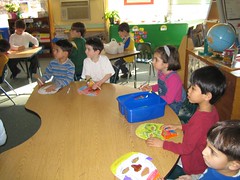By MsMentorAdmin
Posted on 2009-11-03
I’m going to have a student teacher in my biology classes next semester. I’ve never done this before, and I’d like to provide her with feedback on effective science teaching practices. Do you have any suggestions for resources on this?
–Deborah, Stockton, California
Congratulations on your new role, and thank you for agreeing to help an aspiring science teacher! You’re the best resource she can have, as you model good teaching and provide feedback on her efforts.
Will your student teacher’s supervisor use university/college protocols or checklists? If these are generic and meant to be used for a variety of subject areas or the supervisor does not have a background in science education, some science-specific protocols and indicators specifically related to science teaching would be helpful to share with your student teacher. Using these written guidelines or rubrics can provide baseline data and show areas of improvement as she becomes more capable and confident under your tutelage. These guidelines can also help you focus your feedback on specific behaviors, which is better than a generic, though still valuable, “good job.” She can also use these guidelines as she observes your teaching.
A math-science partnership project with which I was involved used two protocols on classroom visits. These could be adapted to meet the needs of your student teacher. Both of these are included in the National Science Foundation’s MSPnet, an electronic learning community with many professional development resources:
- The Science Classroom Observation Guide from the North Cascades and Olympic Science Partnership is user-friendly and concise. This one-page document includes indicators (or “look-fors”) on classroom culture, science content, instruction for understanding, and organizing/applying scientific knowledge. This protocol is different: it focuses on what students are doing as a result of the teacher’s instruction, rather than strictly a direct measure of the teacher’s performance.
- Inside the Classroom Observation and Analytic Protocol from Horizon Research is a comprehensive instrument that can be used in both science and mathematics classes. It’s very lengthy and could be overwhelming for both the observer and the teacher, but it offers some additional ideas.
Classroom management is a challenge for new teachers, especially in science classes where students are using equipment and materials. To help your student teacher, look up Victor Sampson’s The Science Management Observation Protocol in the December 2004 issue of The Science Teacher (you can access it online in NSTA’s Science Store where journal articles are available free to NSTA members, and for a nominal cost to non-members). This article includes checklists tailored to inquiry-based science classes: classroom routines, use of time, collaboration, safety, and the care and use of materials.
When using protocols such as these, it’s important to remember that any given lesson will not exemplify or include every item. They list exemplary practices but do not prescribe which would be appropriate in a given situation. That’s where your experience and expertise will be helpful to your student teacher. Even experienced teachers could benefit from looking at these protocols and reflecting on a recent lesson.
Another priceless resource on effective teaching you could share is a guided tour of the many resources available to NSTA members, starting with the portal Preservice and New Teachers. Good luck!



 Strands of silk woven into a tapestry. Single strands of thread twined into rope. Strands can be a simple foundation for something greater—more beautiful, stronger, or useful. Following a strand at an NSTA regional conference can have a similar result, combining several sessions into a comprehensive professional development experience.
Strands of silk woven into a tapestry. Single strands of thread twined into rope. Strands can be a simple foundation for something greater—more beautiful, stronger, or useful. Following a strand at an NSTA regional conference can have a similar result, combining several sessions into a comprehensive professional development experience.
 What does SciGirls, Bonsais, wind turbines, pasta bridges have in common? They all are aspects of the science rich community of Minneapolis, MN. The first Science Matters community event was held on Saturday morning for elementary science teachers and parents. It was a great success. There were 200 + people, stations to do science, lots free materials and great community resources and ideas for teachers and parents. The participants interacted with at least 15 community organizations.
What does SciGirls, Bonsais, wind turbines, pasta bridges have in common? They all are aspects of the science rich community of Minneapolis, MN. The first Science Matters community event was held on Saturday morning for elementary science teachers and parents. It was a great success. There were 200 + people, stations to do science, lots free materials and great community resources and ideas for teachers and parents. The participants interacted with at least 15 community organizations. October 30—It is Friday but I must tell you about the
October 30—It is Friday but I must tell you about the